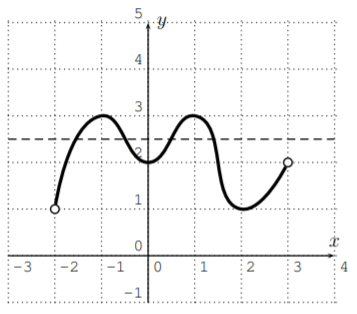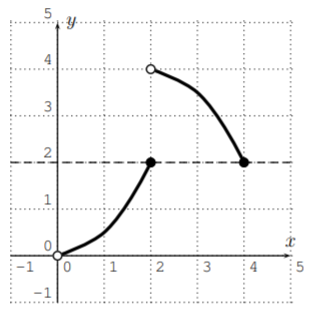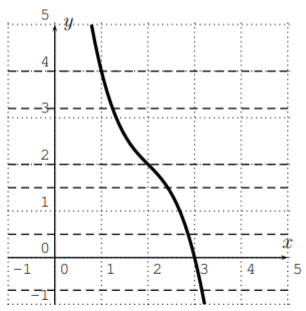7.1: Funciones uno a uno
- Page ID
- 117801
Hemos visto que algunas funciones\(f\) pueden tener las mismas salidas para diferentes entradas. Por ejemplo para\(f(x)=x^2\), las entradas\(x=2\) y\(x=-2\) tienen la misma salida\(f(2)=4\) y\(f(-2)=4\). Una función es uno a uno, precisamente cuando no es así.
Una función\(f\) se llama uno a uno (o inyectivo), si dos entradas diferentes\(x_1\neq x_2\) siempre tienen diferentes salidas\(f(x_1)\neq f(x_2)\).
Como se señaló anteriormente, la función no\(f(x)=x^2\) es uno a uno, porque, por ejemplo, para entradas\(2\) y\(-2\), tenemos la misma salida
\[f(-2)=(-2)^2=4, \quad\quad f(2)=2^2=4 \nonumber \]
Por otro lado,\(g(x)=x^3\) es uno a uno, ya que, por ejemplo, para entradas\(-2\) y\(2\), tenemos diferentes salidas:
\[g(-2)=(-2)^3=-8, \quad\quad g(2)=2^3=8 \nonumber \]
La diferencia entre las funciones\(f\) y se\(g\) puede ver a partir de sus gráficas.
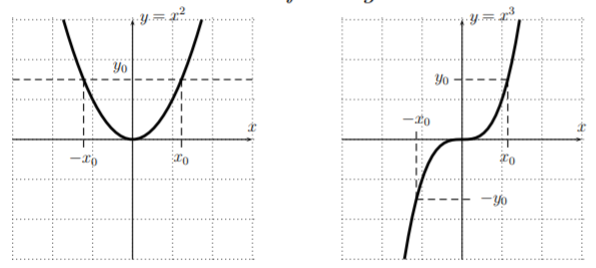
La gráfica de\(f(x)=x^2\) la izquierda tiene para diferentes entradas (\(x_0\)y\(-x_0\)) la misma salida (\(y_0=(x_0)^2=(-x_0)^2\)). Esto se muestra en la gráfica ya que la línea horizontal en\(y_0\) intersecta la gráfica en dos puntos diferentes. En general, dos entradas que tienen la misma salida\(y_0\) dan dos puntos en la gráfica que también se encuentran en la línea horizontal en\(y_0\).
Ahora, la gráfica de\(g(x)=x^3\) la derecha se cruza con una línea horizontal en alguna\(y_0\) sólo una vez. Esto demuestra que para dos entradas diferentes, nunca podremos tener la misma salida\(y_0\), por lo que la función\(g\) es uno-a-uno.
Podemos resumir la observación del último ejemplo en el siguiente enunciado.
Una función es uno a uno exactamente cuando cada línea horizontal intersecta el gráfico de la función como máximo una vez.
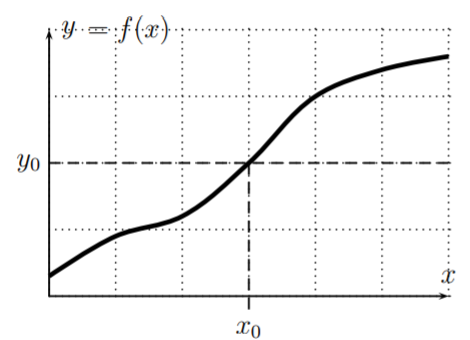
¿Cuáles de las siguientes son o representan funciones uno-a-uno?

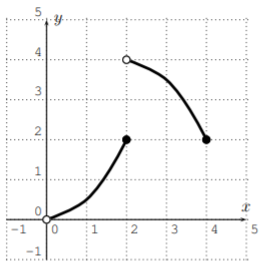
- \(f(x)=-x^3+6x^2-13x+12\)
- \(f(x)=x^3-2x^2+3\)
Solución
Utilizamos la prueba de línea horizontal para ver qué funciones son uno a uno. Para (a) y (b), vemos que las funciones no son uno-a-uno ya que hay una línea horizontal que se cruza con la gráfica más de una vez:
Para (c), usando la calculadora para graficar la función\(f(x)=-x^3+6x^2-13x+12\), vemos que todas las líneas horizontales se cruzan con la gráfica exactamente una vez. Por lo tanto, la función en la parte (c) es uno a uno. Sin embargo, la función en la parte (d) tiene una gráfica que cruza alguna línea horizontal en varios puntos. Por lo tanto, no\(f(x)=x^3-2x^2+3\) es uno a uno:



